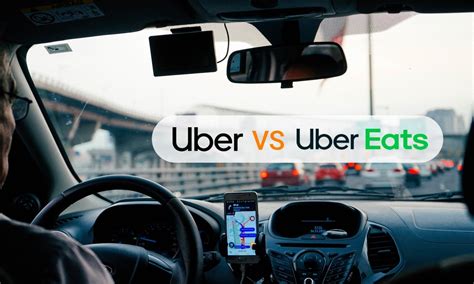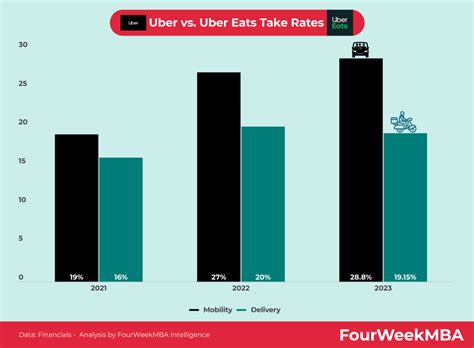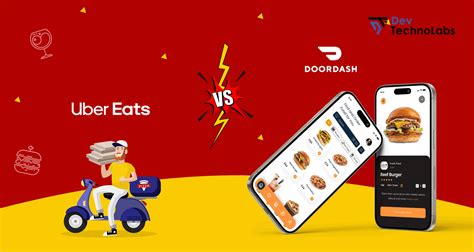Uber Vs Uber Eats Pay

The comparison between Uber and Uber Eats pay structures is a topic of interest for many, especially those considering gig work opportunities. As a reliable and knowledgeable source, I will delve into this topic, providing an in-depth analysis to help readers understand the nuances of each platform's compensation system.
Understanding the Uber Pay Structure

The pay structure for Uber, the ride-sharing giant, has evolved over the years to become more driver-friendly and competitive in the market. Uber’s compensation system is designed to incentivize drivers and ensure a steady stream of income. Here’s a breakdown of the key components:
Fare Calculation
Uber calculates fares based on a combination of factors, including distance traveled, time taken for the trip, and demand surges. The base fare covers the initial pickup and mileage, while additional charges are applied for time spent on the trip and any applicable tolls or airport fees.
| Fare Component | Description |
|---|---|
| Base Fare | Covers initial pickup and a certain distance. |
| Mileage Rate | Rate per mile (or kilometer) traveled beyond the base distance. |
| Time Rate | Rate per minute for the duration of the trip. |
| Surge Pricing | Dynamic pricing during periods of high demand. |

Incentives and Bonuses
Uber offers various incentives and bonuses to drivers to promote high acceptance rates and encourage peak hour driving. These can include:
- New Driver Bonuses: Sign-up bonuses to attract new drivers to the platform.
- Referral Bonuses: Rewards for referring new drivers.
- High Demand Bonuses: Additional earnings for working during busy periods.
- Long Trip Bonuses: Incentives for accepting longer-distance trips.
Unraveling the Uber Eats Pay

Uber Eats, the food delivery service, operates on a slightly different pay structure compared to its ride-sharing counterpart. Here’s an overview of how Uber Eats compensates its delivery partners:
Delivery Fees
Uber Eats charges a delivery fee for each order, which is paid by the customer. A portion of this fee goes to the delivery partner as their base earnings for the delivery.
Promotions and Incentives
Similar to Uber, Uber Eats offers promotions and incentives to its delivery partners. These can include:
- New Partner Bonuses: Sign-up bonuses to encourage new drivers to join.
- Referral Bonuses: Rewards for referring new delivery partners.
- Peak Pay: Increased earnings during busy periods or for completing a certain number of deliveries.
- Challenges: Incentives for completing a specific number of deliveries within a set time frame.
Tips and Earnings
Customers can choose to tip their delivery partners through the Uber Eats app. These tips are entirely optional but can significantly boost a delivery partner’s earnings. Uber Eats does not take a cut from the tips received by its partners.
Comparative Analysis: Uber vs. Uber Eats Pay
Now, let’s compare the pay structures of Uber and Uber Eats to understand the key differences and similarities:
Earnings Potential
Both platforms offer the potential for high earnings, especially during peak hours or through various incentives. However, Uber drivers typically earn more per trip, as their compensation includes a base fare, mileage rate, and time rate. Uber Eats delivery partners, on the other hand, rely more heavily on delivery fees and customer tips.
Work Flexibility
Uber and Uber Eats both provide flexible work opportunities, allowing drivers and delivery partners to choose their own hours. However, Uber drivers may have more flexibility in choosing their rides, as they can decline trip requests. Uber Eats delivery partners, on the other hand, are often dispatched to the closest available order, providing less control over their delivery assignments.
Incentive Structures
Both platforms offer a range of incentives and bonuses to motivate their workers. Uber’s incentives are more focused on promoting high acceptance rates and peak hour driving, while Uber Eats incentives are designed to encourage a higher volume of deliveries and attract new delivery partners.
The Bottom Line: Choosing Between Uber and Uber Eats Pay
The decision to work for Uber or Uber Eats ultimately depends on individual preferences and circumstances. Here are some factors to consider:
- Earnings Potential: If higher earnings per trip are preferred, Uber may be the better choice. For those seeking a steady income with potential for tips, Uber Eats could be more suitable.
- Work Flexibility: Uber drivers have more control over their rides, while Uber Eats delivery partners may experience more dispatch-based assignments.
- Incentive Structures: Review the incentive programs offered by each platform to determine which align better with your work goals and preferences.
Remember, both platforms offer unique opportunities and benefits. It's essential to weigh these factors and consider your personal circumstances to make an informed decision about which platform suits your needs best.
Are there any guaranteed earnings for Uber drivers?
+Uber does not guarantee a specific income for its drivers. Earnings vary based on factors like location, time of day, and driver acceptance rates. However, Uber does offer various incentives and bonuses to boost earnings during peak hours or for high acceptance rates.
How are Uber Eats delivery partners compensated for tips?
+Uber Eats delivery partners receive 100% of the tips from customers. These tips are in addition to the base delivery fee and any promotions or incentives offered by Uber Eats.
Can Uber drivers and Uber Eats delivery partners work for both platforms simultaneously?
+Yes, it is possible to work for both Uber and Uber Eats simultaneously. Many drivers choose to diversify their income streams by working for multiple platforms. However, it’s important to manage time and commitments effectively to ensure a positive experience on both platforms.


